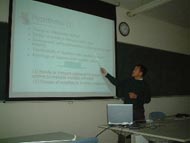The 5th WORKSHOP 22 November 2003 (Sat), GRIPS, Tokyo 14:00-16:00 |
| Subject:
Regional Supplier Networks and Competitive Advantage: Case Studies of
Honda and Vietnamese Motorcycle Companies
by Mr Pham Truong Hoang |
|
The fifth workshop of JVEC was held on November 22, 2003 at GRIPS with the presentation of Mr. Pham Truong Hoang on the "Regional Supplier Networks and Competitive Advantage - Case Studies of Honda and Vietnamese Motorcycle Companies." This was the preliminary version of his master thesis, which would be submitted to the Graduate School of Information and Environment Sciences of Yokohama National University. After outlining key concepts concerning the supplier system and product architecture, especially the closed vs. open and modular vs. integral models, he classified the Japanese traditional supplier system to be a closed-integral system. He then reviewed the motorcycle industry in Vietnam and East Asia, including analyses on the suppliers, consumers, and market shares and segmentation. With this background, the author proposed four hypotheses on Honda Vietnam (HVN) and other Vietnamese motorcycle companies: in response to changing markets and especially the emergence of China as a supplier of motorcycles, (i) HVN enlarged its supplier system to
include the regional supplier network Based on interviews and internal documents, the author analyzed the recent change in HVN supplier system for the Wave Alpha model. In particular, he noted that the new supplier system of HVN outsourced non-core components from the non-Honda group supplier in China (which was never observed before), and evaluated the strong and weak points of this new system. These facts seemed to confirm the above hypotheses except (iii), which was rejected. HVN was geographically expanding the supply regions but not changing its model from integral to modular. The current situation of Vietnamese producers of motorcycles using Chinese parts (their products are normally called the "Chinese" motorbikes) was additionally explained. The presentation attracted a lot of comments and questions. First, the methodology and purposes of study were questioned, as they were not clearly presented. Then, there were some problems in evaluating the quality of the new supplier system of HVN, which might require more quantitatively precise methods. The need to compare HVN with other motorcycle companies and study other markets was also discussed. The possibility of market segmentation was also pointed out, especially the differences between rural and urban markets. The issue that attracted most attention was the cause of the large price reduction in HVN's Wave Alpha, which might not be explained only by the introduction of the new supplier system. There were also views that the new supplier system of HVN might not be unique but also visible in other countries, including Japan, in the context of globalization. However, the author replied that modularization had been a relatively rare phenomenon in motorcycles, unlike electronics and computers. There was also a discussion on the localization policy of the government, its effects on the motorcycle industry, as well as the prospects for the Vietnamese motorcycle market in the future. The author was advised to clarify the structure of his argument further, especially the presentation of key concepts and hypotheses, to make the research more consistent and interesting. The author thanked all these opinions, comments, and questions which would be very useful for improving his work in progress.
|

